Discovering the Edge of the Solar System
By Chadwick Trujillo
Recent discoveries suggest that planets larger than Pluto may exist in the outer reaches of our solar system
Recent discoveries suggest that planets larger than Pluto may exist in the outer reaches of our solar system

DOI: 10.1511/2003.32.424
The last planet to be discovered in our solar system was Pluto, found by Clyde Tombaugh nearly 75 years ago. Pluto lay just beyond the most distant gas giants, Uranus and Neptune, and its discovery suggested to astronomers that the edge of the solar system had yet to be found.
What's more, Pluto has some strange qualities compared with its giant neighbors: It's about a thousand times less massive, it's made mostly of rock and ice (as opposed to gas), and it has an elongated orbit, which is inclined to the orbital plane of the solar system. This oddity was an early clue that the outer limits of the solar system might be worlds apart in character from the giant outer planets.
Although various scientists had suggested that the region beyond Neptune consists of more than just Pluto, it wasn't until 1992 that another trans-Neptunian object was discovered by David Jewitt and Jane Luu, both then at the University of Hawaii. The object they found, with the unassuming name of (15760) 1992 QB1, appears to be about 130 kilometers in diameter, giving it the same land area as West Virginia. This is tiny compared with Uranus and Neptune, which are each about 50,000 kilometers across, and still much smaller than Pluto, which has a diameter of about 2,320 kilometers.
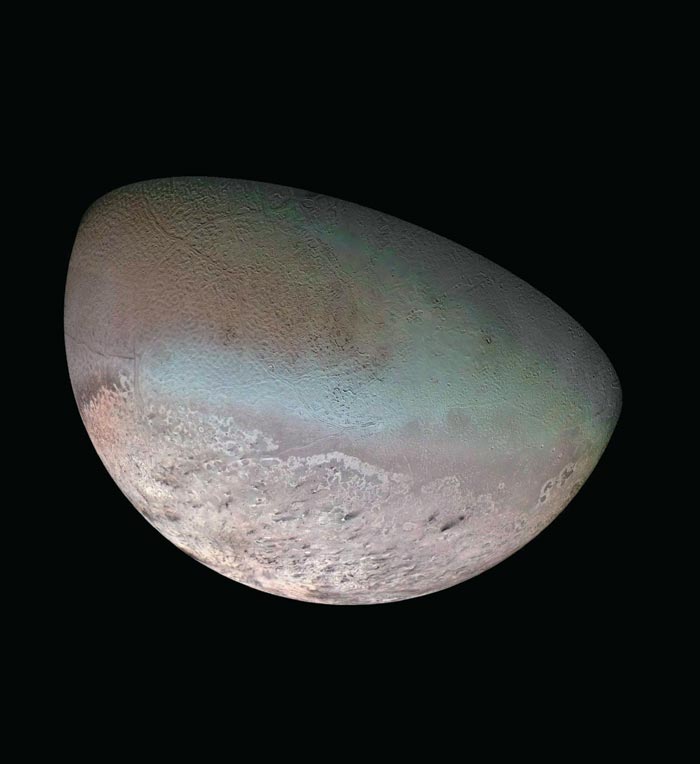
Image courtesy of NASA
Before (15760) 1992 QB1 and similar trans-Neptunian objects were found, scientists generally believed that these bodies would be between 1 and 10 kilometers across. But since 1992 more than 800 objects have been discovered, and most of them are about 100 kilometers in diameter. Together these trans-Neptunian bodies form a relatively flat, ring-shaped structure around the Sun that has been dubbed the "Kuiper belt," in recognition of Dutch astronomer Gerard Kuiper's 1951 proposal that undiscovered bodies lay outside the orbits of Neptune and Pluto. It turns out that an Irish amateur astronomer, Kenneth Edgeworth, was the first to mention the existence of such a region in 1943, so it's also sometimes called the "Edgeworth-Kuiper belt." (In 1930, just six months after Pluto's discovery, University of Chicago astronomer Frederick Leonard also mentioned the possibility that more Pluto-sized bodies might exist, but the name "Leonard-Edgeworth-Kuiper" has not received much attention.)
Edgeworth and Kuiper originally proposed the idea of a trans-Neptunian belt to help explain the origin of short-period comets, those with orbital periods of less than 200 years. In this view the belt served as a reservoir for the icy objects that would occasionally fall into the inner solar system. It is now generally recognized that this is indeed the case. However, the Kuiper belt is even more interesting because the bodies are considered to be the primordial remnants of the nascent solar system. The Kuiper belt objects, or KBOs, are some of the oldest unaltered bodies in the solar system and so represent an unexplored source of knowledge about its early history.
Interestingly, the KBOs seem to be even larger than many scientists suspected before the first KBOs were found. In June 2002, my colleague Michael Brown at the California Institute of Technology and I discovered the largest known KBO, which we named Quaoar (pronounced "KWAH-o-wahr"), after a deity of the native American Tongva people, many of whom still live in the Los Angeles area. Quaoar is about 1,300 kilometers in diameter, roughly half the size of Pluto. The existence of such a large KBO, along with a few others in the 1,000-kilometer range, suggests that there may be even larger objects out there. In this article I briefly describe what scientists have learned about the KBOs, especially the very large ones that were discovered in the past few years.
The Kuiper belt has only been known for 11 years, but its overall structure is reasonably well understood, even if a number of mysteries remain. The 800 known KBOs constitute only about three percent of the expected total population, which can be estimated by extrapolating from the very small portion of the sky that has been searched. Using such methods astronomers have surmised that there are about 30,000 KBOs larger than 100 kilometers in diameter. This makes the Kuiper belt population about 100 times greater in number and mass than the asteroid belt between Mars and Jupiter.
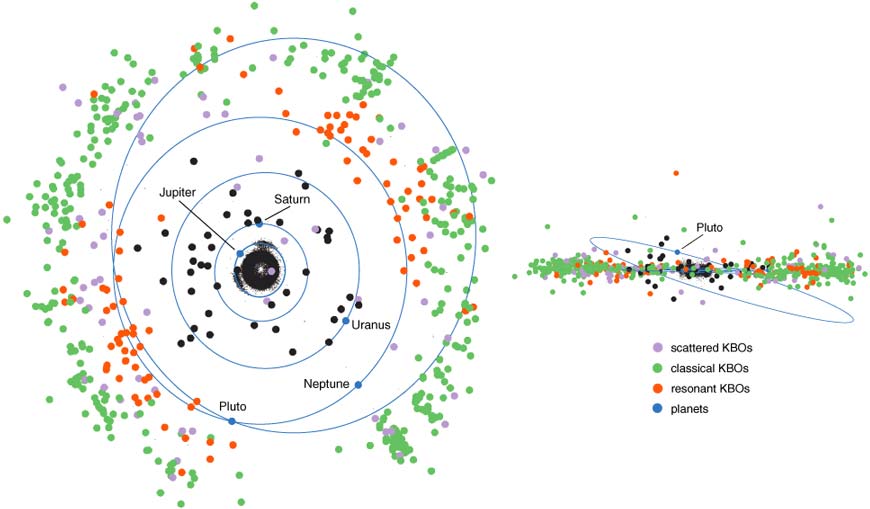
Tom Dunne
There appear to be three types of KBOs, which are distinguished primarily by their dynamic properties. About 50 percent of the KBOs have nearly circular orbits (eccentricities less than 0.2) and inhabit a ring-shaped structure between 42 and 48 astronomical units (AU) from the Sun (one AU is the distance between the Sun and the Earth). These are called the classical KBOs because they more or less conform to the original idea that the Kuiper belt consisted of a relatively thin disk at the edge of the solar system. Another 10 percent of the KBOs are in mean-motion resonance with Neptune (as is Pluto). Most of the resonant KBOs orbit the Sun only once or twice for every three times Neptune orbits the Sun. Resonance protects these small, icy KBOs from close passage to the giant planet, which would otherwise pull them towards the inner solar system (where they might become comets), or fling them even farther from the Sun. The remaining 40 percent appear to have undergone a weak gravitational interaction with Neptune, which has scattered them into highly eccentric orbits. The orbits of the scattered KBOs can carry them anywhere from the inner part of the classical belt outward to the most distant parts of the known solar system, up to 30 times the distance between the Sun and Neptune, roughly 900 AU!
Although these three populations have been identified, there are some fundamental observations about the belt that currently defy explanation. Among these is the presence of the outer edge displayed by the classical Kuiper belt: Beyond 48 AU none of the KBOs have circular orbits. There are several possible explanations for this outer edge, all involving catastrophic events during the early stages of our solar system's formation. In one scenario, material in the outer solar system was stripped away by a close-passing star. In another view, Earth-sized planets may have passed through the primordial Kuiper belt, disrupting its disk structure. A third possibility is that some additional resonances with Neptune may have played a role in creating the outer edge. However, no theory has been widely accepted.
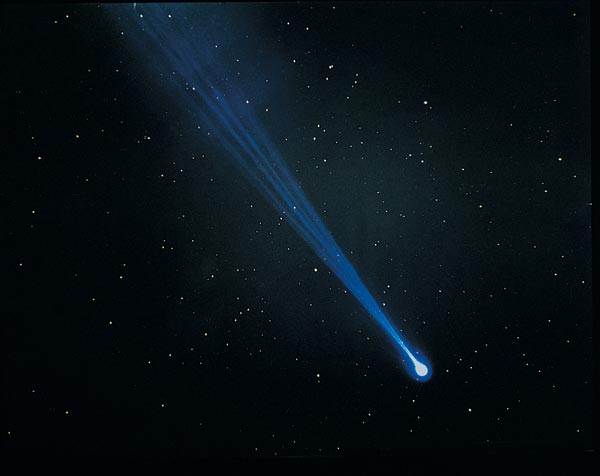
Ronald Royer/Science Photo Library
The Kuiper belt's thickness also came as a surprise to observers. The basic theory was that KBOs inhabited a very thin disk, less than one degree above or below the plane of the solar system—something that was required for the KBOs to form by gravitational accretion. In fact, the Kuiper belt is actually about 10-degrees thick, plus a "halo" of objects with much higher inclinations. This extra thickness suggests that the belt was somehow stirred up after the solar system formed, possibly by some of the same processes suggested to explain the outer edge.
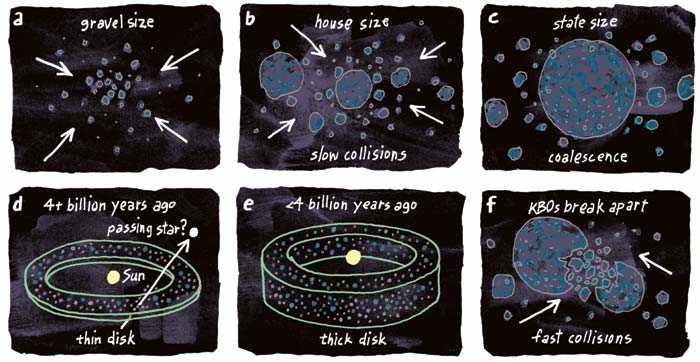
Tom Dunne
The KBOs vary in color from nearly the reddest objects in the solar system to a bland gray. Although much work has been done to measure the colors of the KBOs, there are few definite conclusions. It does appear that KBOs that travel in very circular orbits in the plane of the solar system tend to be red. Some scientists have suggested that collisions could be responsible for the coloring. Left undisturbed, KBOs will slowly redden over time as they are "baked" by galactic cosmic rays and high-energy ultraviolet radiation from the Sun. Collisions could excavate pristine gray material from the interior. So objects that have suffered recent collisions might appear gray, whereas objects with older surfaces would appear darker and redder. Others have proposed that the observed color distribution is a leftover from the formation of the solar system—the different colors corresponding to regional differences in the chemistry and composition of the primordial solar nebula. It's known that the chemicals that dominate the planetary bodies vary greatly: The inner planets are mostly rock, whereas the outer "gas giants" are made of gas and ice. For example, if some of the KBOs formed near Jupiter and later moved beyond Neptune, while others formed beyond Neptune and stayed there, one might expect to see differences in color and composition between these two populations.
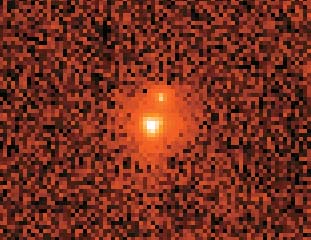
Photograph courtesy of the Trujillo
We know very little about the surfaces of the large KBOs, except that their colors vary widely and that some appear to have water ice (as revealed in spectroscopic studies). This isn't much of a surprise because the KBOs are thought to be the parent bodies of the comets, which are rich in water ice. Unfortunately, the vast majority of telescopic studies of KBOs have revealed very little information about their surface composition, mostly because even the brightest of the objects are difficult to study from Earth. One of the best clues to the appearance of a KBO's surface was provided in 1989 when Voyager II cruised by Neptune's large moon Triton—several years before the first KBO was discovered.
In fact, Pluto, its moon Charon, Triton and the Kuiper belt may be more closely related than one might guess at first. Many scientists have considered the possibility that Pluto may be accurately characterized as the largest KBO rather than a planet. (The Rose Center for Earth and Space in New York city, for example, removed Pluto from its list of planets in 2000.) This is because there are about 10 or 20 KBOs that have orbits very similar to Pluto's. Pluto's moon, Charon, was probably formed during a collision between Pluto and a KBO in the early solar system—making Charon a product of the KBOs. Triton, because it circles Neptune "backward" (compared with the orbits of Neptune's other moons and with the orbits of the planets around the Sun, is believed to be a captured satellite—a KBO-turned-Neptunian moon. Indeed Triton is often suggested as a possible analogue to Pluto's surface, which will be explored when NASA's New Horizons Pluto-Kuiper belt mission visits the small planet in 2015.
Several KBOs also appear to have their own little moons. These are often very far from the parent body—between 10,000 and 100,000 kilometers—and quite large, nearly one-third the diameter of the parent body. Their separations relative to their sizes are somewhat similar to the Earth-Moon system, which is quite surprising because the KBOs are typically about one-millionth the mass of the Earth. Their existence is quite inexplicable by the standard collisional mechanism used to explain our Moon's formation—the impact of a Mars-sized body on the Earth.
This assortment of mysteries is particularly vexing because it's not clear whether an experiment could be devised that would lead to a definitive explanation of the observations. Most of the belt's features are probably relics of the solar system's formation, and so far we know little about what happened in the outer solar system. Theoreticians attempt to model this process with dynamic simulations of growing bodies in the Kuiper belt. The standard paradigm is that the KBOs formed from the coalescence of smaller bodies, perhaps one kilometer across, early in the solar system's history. At some point, however, there was a drastic change in the properties of the Kuiper belt, which arrested the gravitational growth of the individual KBOs. This may have been the event or series of events that stirred up the belt to make it thicker and produced the outer edge.
We can, in fact, make an observation that can tell us how far the growth process proceeded—that is, we can look for the largest KBO. This would tell us how large a body could grow before the aggregation stopped. But this is not a small task; it means we must look through the entire sky and find the largest KBOs.
The biggest KBOs are also the brightest, so very large telescopes are not needed. However, the search is still difficult for the simple reason that the sky is immense. To get some sense of the task, it helps to know that a typical "wide-field" professional telescope capable of detecting the brightest KBOs has a field of view that is about one-third the diameter of the full Moon, or about 0.2 degree across. It takes about 150,000 full Moons to fill the sky, so if one took a wide-field exposure every minute, it would require nearly six years of clear nights to search the whole sky. My colleagues and I are currently engaged in the task of searching for large KBOs by using a telescope with an extremely wide field of view and a camera that captures nearly three square degrees, about 10 times the area of the full Moon.

Tom Dunne
The camera is a charge-coupled device, or CCD, a silicon-based electronic instrument that can capture faint astronomical images in a fraction of the time needed for film or other emulsion-based systems. These cameras have three main advantages over conventional photography: They are about 100 times more sensitive to photons, they are very sensitive to red light (where KBOs are brightest), and the images collected during a CCD exposure are downloaded directly to a computer, immediately facilitating processing.
We use a semi-automated procedure (some human intervention is involved), and this has had a profound impact on the search for KBOs simply because a machine is so much faster (and less prone to error) than a human being. Many large KBOs, including Quaoar, have been discovered this way. Three images of the same patch of sky are taken in sequence, about 90 minutes apart. Each exposure is only about 2.5 minutes long, which is much shorter than the many nights of exposure required to reveal the most distant galaxies. Each image is analyzed by an automated algorithm, which identifies objects that appear to move during the time sequence. Many false positives are identified along with the real moving objects, and so an astronomer must look at the images to eliminate the "false discoveries." This semi-automated approach is also used by many astronomers searching for potentially hazardous near-Earth asteroids.

Photograph courtesy of Trujillo
In the past few years, the search process has also been aided by the development of robotic telescopes. These telescopes have the ability to operate autonomously, examining a small part of the sky and then systematically moving on to the next target. Most are multi-million-dollar opto-mechanical systems, coupled to millions of dollars of detector instrumentation, all housed in a protective enclosure. Even though some telescopes have the ability to close automatically during hazardous weather, they are almost always monitored by a human operator nearby.
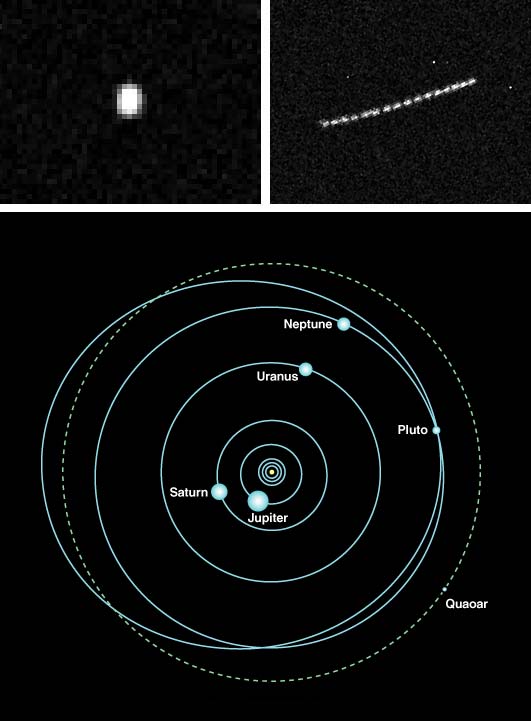
Top two images courtesy of NASA and Michael Brown, Caltech. Illustration courtesy of Tom Dunne.
Our ongoing survey of the sky for KBOs uses the Palomar Oschin Telescope, which has a mirror diameter of 1.2 meters—relatively tiny compared with the 8 to 10-meter giants that have been built in the past decade. However, the Oschin telescope is a reliable workhorse that has been in operation since 1948. Fortunately for us it was recently upgraded by the Near Earth Asteroid Tracking program (NEAT), which searches for asteroids that might collide with the Earth. This telescope executes its exposures robotically, seamlessly trading time between our survey and the NEAT program.
The combination of a semi-automated telescope and analysis software allows large-scale surveys to be done with a minimum of manpower. Our survey, which in a year and a half has covered about 5,000 square degrees (roughly one-eighth of the sky), can be operated by a single astronomer working during the day and a small crew to ensure proper maintenance and operation of the telescope. Clyde Tombaugh spent 14 years examining 30,000 square degrees of photographic plates by eye to find Pluto. At our current pace we'll be able to cover the entire sky in about 12 years, with instruments that are 50 times more sensitive than he used—a striking testimony to the advantages of silicon-based technologies.
Quaoar is about 100 times brighter (at red wavelengths) than the typical KBO and about twice as bright as the next brightest object. So why wasn't Quaoar discovered before June 2002? Quaoar is just a little too dim for Tombaugh to have discovered it, but one would have expected that other surveys in the 20th century might have seen it. And, indeed, a look at previous sky surveys reveals that others had recorded its presence, but did not recognize it because they weren't looking for moving objects. Those who were looking for moving objects weren't looking for ones that were moving so slowly (and, hence, were so far away). In some instances Quaoar was near the survey's faintness limit. Although Quaoar is considered to be bright, it is still about 100 times fainter than Pluto, which is considered to be a very difficult target for eyeball-based observing even with large amateur telescopes.
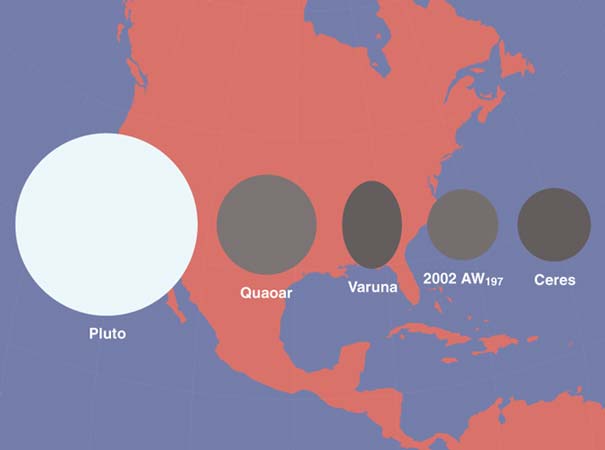
Tom Dunne
Determining the size of Quaoar is no easy task. The telescope records an object's position and brightness, but one must fit an orbit to at least three observed positions to produce a distance estimate. We see Quaoar by light that has traveled 6.5 billion kilometers from the Sun to Quaoar's surface and then reflected back to the Earth another 6.3 billion kilometers. By knowing Quaoar's distance and the amount of light reflected back to a telescope, we can get a general idea of its size. But because we don't know Quaoar's albedo—a small, snow-covered surface could reflect the same amount of light as a large, charcoal-covered surface—this technique is relatively crude.
One way to resolve this ambiguity is to measure the heat emanating from Quaoar. An object's thermal emission tells us how much light it has absorbed and so how dark its surface must be. These measurements were performed by a 30-meter radio telescope in Spain, at the Institute for Radioastronomy in the Millimeter Range (IRAM). The measurement is difficult to make because KBOs are very cold (about 42 kelvins)—only the five or so largest KBOs can be measured with any precision this way. By combining them with our own optical measurements of its position and brightness, we estimated Quaoar to be about 1,300 kilometers in diameter.
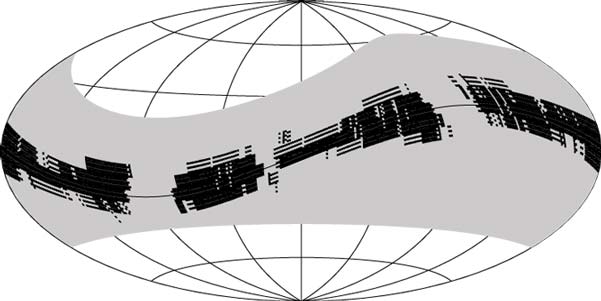
Image courtesy of Chadwick A. Trujillo.
Although there are many systematic biases to this technique, we had an independent way to verify this measurement. It turns out that Quaoar is sufficiently large for the Hubble Space Telescope (HST) to resolve it into a disk. By comparing its apparent size (about 1.5 pixels) to that of a star (which is essentially a pinpoint, zero pixels across) we were able to determine that Quaoar is about 1,250 kilometers across. Such a precise measurement is difficult to perform because the optical system of HST must be very well understood. The comparison of the star is essential to demonstrate that we understand the distortions created in the HST optics, even though, after the corrective COSTAR installation in 1993, it is one of the most optically perfect telescopes in the world.
The presence of the largest and brightest KBOs has only been confirmed in the past few years. Of the 10 intrinsically brightest KBOs, all have been found since 2000. Because only a small fraction of the sky has been examined for these bright KBOs, it is likely that more exist and remain to be discovered. Although our survey has found what is currently the largest KBO since Pluto's discovery, we have only covered a fraction of Tombaugh's survey, and an even smaller fraction of the whole sky. We hope to continue our survey, eventually covering about the same amount of sky as Tombaugh, but we should be able to detect objects 50 times fainter. We have only imaged about one-eighth of the whole sky, and about one-fifth of the sky where KBOs are most likely to be found (near the plane of the solar system). To date we have found about 30 bright KBOs, with Quaoar and 2002 AW197 having the largest diameters, about 1,250 and 900 kilometers, respectively.
As we search the remaining four-fifths of the sky, we expect to find a total of about 100 bright KBOs, with perhaps 10 KBOs in the 1,000-kilometer-diameter range. The size distribution of the Kuiper belt is such that for every 15 objects found of a given diameter, one will be found with twice that diameter. So of the 10 KBOs in the 1,000-kilometer range, it is possible that one will be about 2,000 kilometers across, approaching Pluto's size. Our survey should be completed in 2005, and with some luck one of the Pluto-sized bodies may appear in our data.
Another possibility is finding a very large object, perhaps as big as Mars. The sky has not been adequately searched for Mars-sized bodies at extreme distances from the Sun—twice as far as the main body of the Kuiper belt. If there are one or two such "super-Plutos" out there, they could easily have escaped Tombaugh's survey because of their faintness and all the other KBO-sensitive surveys because of the small amount of sky examined. There are no good theoretical or observational limits to the existence or non-existence of such large bodies—except for the distant hope that we have yet to find the outer edge of our solar system.
The author wishes to thank Michael E. Brown, who provided valuable input to much of the research presented in this article.
Click "American Scientist" to access home page
American Scientist Comments and Discussion
To discuss our articles or comment on them, please share them and tag American Scientist on social media platforms. Here are links to our profiles on Twitter, Facebook, and LinkedIn.
If we re-share your post, we will moderate comments/discussion following our comments policy.